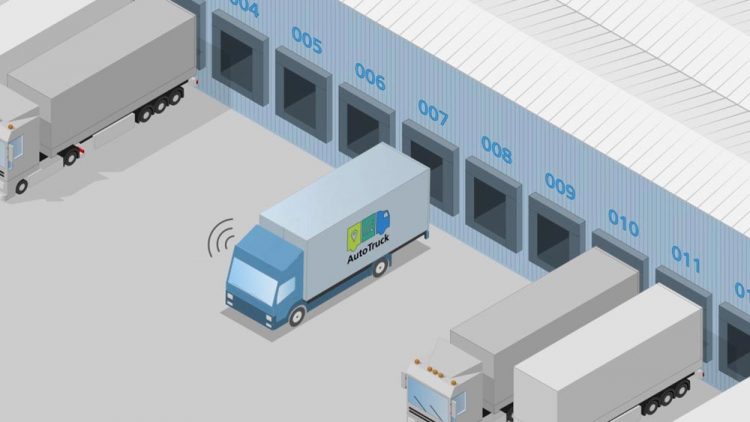Autonomous trucks for logistics centers

The truck drives independently to the loading ramp and waits until it is loaded. (c) Fraunhofer IVI
Tired and exhausted from the long route, the truck driver arrives at the depot. However, instead of driving the vehicle to the loading ramp, waiting there until it is fully loaded and then parking the truck in the parking lot, the driver can enjoy his well-deserved after-work hours earlier: he already leaves at the gate to the depot – the truck does everything else by itself. In other words: it drives independently to the loading ramp, waits until it is loaded and then parks in the parking lot.
Autonomous vehicles in automation zones
Scientists at the Fraunhofer Institute for Transportation and Infrastructure Systems IVI are making this possible in cooperation with various industrial partners in the AutoTruck project. The researchers have deliberately set their sights on automation zones, such as mines, truck depots, ports and company premises.
In contrast to autonomous driving on the road, self-driving vehicles in such demarcated areas can be more effectively controlled: the people who circulate there can be instructed in advance, and access is not permitted to unauthorized individuals. In addition, the autonomous vehicles do not need any road registration there, but rather only machine approval. At a maximum of 15 to 20 kilometers per hour, the speeds are significantly lower than in road traffic.
“Compared to road traffic, specially equipped automation zones have a decisive advantage: autonomous vehicles ready for registration will be able to be used there in the near future,” says Dr. Sebastian Wagner, Group Manager at the Fraunhofer IVI. “It’s true that controlled conditions prevail in these spatially delimited areas. Nevertheless, key challenges have to be solved here, as well, that are relevant and transferable for public road traffic.”
Of course, this is not the only motivation: the autonomously driving vehicles provide numerous advantages for the operators of depots and the like. On the one hand, they can counteract the demographic change, since it is becoming increasingly difficult to recruit truck drivers. In addition, the autonomous vehicles would be able to operate day and night, making fewer mistakes along with lowering the number of accidents as well as the costs. The technologies developed in the AutoTruck project will be demonstrated and further developed at the depot of the project partner Emons Spedition GmbH.
Centerpiece: Online control center
At the heart of the Fraunhofer development is an online control center, more precisely the HelyOS system, short for “highly efficient online yard operating system”. This can be operated via standard Internet browsers worldwide. Therefore, instead of having to employ one driver in each truck, a single operator can, for example, control 30 vehicles in Munich or even 50 in Dresden.
The vehicles are displayed on a digital map on the Internet – if desired, the operator can also superimpose maps from a survey office. In the control room, he can not only see where the individual vehicles are located, but also monitor them and retrieve status information, such as battery level, loading condition, etc.
And: He can send missions and work orders to the vehicles, such as by clicking on a target position on the map. With such a click, the control center starts the live maneuver planning TruckTrix, which was also developed by the Fraunhofer IVI. TruckTrix calculates the complete path along which the truck is to travel.
The system not only takes into account the geometry of the vehicle, but also fixed obstacles as well as the routes of other autonomous vehicles. In order to be able to take the fixed obstacles into consideration, the researchers have extended the maps with the corresponding information as well as with information concerning where driveable areas are located. TruckTrix is available as an online service via an interface for users and customers.
The calculated routes are sent to the trucks in which Fraunhofer IVI researchers have integrated standard electrical controls. Control algorithms, also from the Fraunhofer IVI, control the drive and the steering in such a way that the target and actual positions always coincide. The tracking system of the lead partner Götting KG continuously determines where the truck is located in the automation zone.
In the spring of 2018, a truck that had been converted for electric drive by the partners was handed over to the Fraunhofer IVI. The electric motor is powered by 305 kilowatts of continuous power from lithium-iron-phosphate batteries. Within the next months, the Fraunhofer IVI researchers plan to install further components, such as sensors, actuators and control devices, for autonomous driving. In a little more than a year, the vehicle will make its first independent trip.
“Many of the developed technologies can be transferred to public road traffic in the medium to long term,” says Wagner, “such as the control algorithms, obstacle detection, the locating solution or the communication between truck and infrastructure.”
https://www.fraunhofer.de/en/press/research-news/2018/July/autonomous-trucks-for…
Media Contact
All latest news from the category: Information Technology
Here you can find a summary of innovations in the fields of information and data processing and up-to-date developments on IT equipment and hardware.
This area covers topics such as IT services, IT architectures, IT management and telecommunications.
Newest articles

A universal framework for spatial biology
SpatialData is a freely accessible tool to unify and integrate data from different omics technologies accounting for spatial information, which can provide holistic insights into health and disease. Biological processes…

How complex biological processes arise
A $20 million grant from the U.S. National Science Foundation (NSF) will support the establishment and operation of the National Synthesis Center for Emergence in the Molecular and Cellular Sciences (NCEMS) at…

Airborne single-photon lidar system achieves high-resolution 3D imaging
Compact, low-power system opens doors for photon-efficient drone and satellite-based environmental monitoring and mapping. Researchers have developed a compact and lightweight single-photon airborne lidar system that can acquire high-resolution 3D…





















